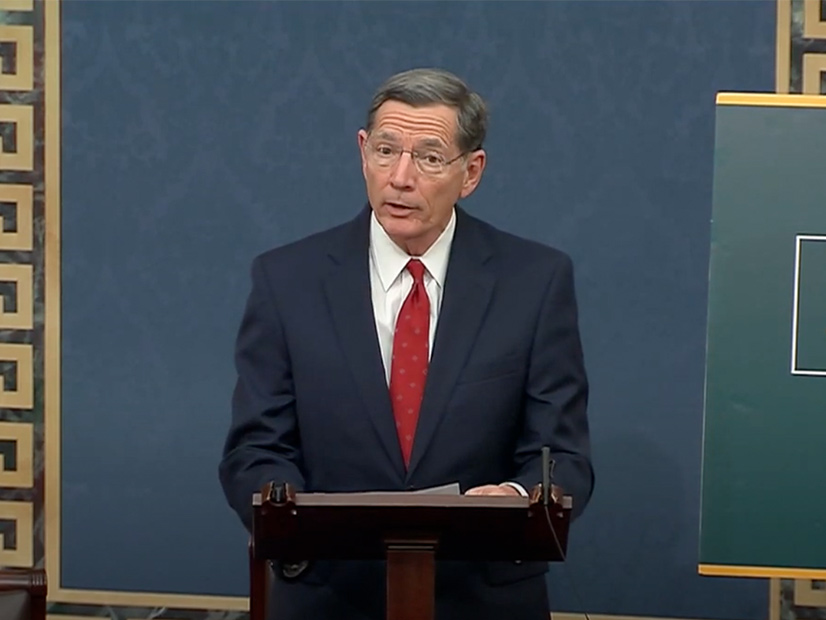In the weeks since President Biden took office, Republican arguments against his plans to decarbonize the U.S. power system by 2035 have become relatively predictable: The plan is an attack on the fossil fuel industry that will destroy jobs, families, communities and America’s energy independence, and what kind of environmental justice is that?
Now, Sen. John Barrasso (R-Wyo.), the ranking member on the Senate Energy and Natural Resources Committee, has upped the ante with a new report, attacking Biden’s climate initiatives as costly retreads of what are viewed as failed policies from the Obama administration.
“The Biden administration seems blinded by the Solyndra Syndrome,” Barrasso said in a speech in the Senate on Monday, invoking the 2011 bankruptcy of a solar startup, which defaulted on a $535 million loan guarantee from the Department of Energy’s Loan Program Office (LPO).
“President Biden wants to use the exact same playbook now, this time with a heftier price tag,” Barrasso said, referring to the president’s proposed $2 trillion in infrastructure spending. “At the same time [that] the Biden administration is recycling far-fetched, so-called jobs plans, the Biden administration is attacking existing oil and gas jobs — good jobs that people have today.”
Barrasso’s report looks back to the Great Recession, the Obama administration’s American Rescue and Recovery Act and its promise of 5 million green jobs, which, the report says, delivered only a tepid recovery.
“At the same time, the oil and gas sector was thriving, producing energy at a furious pace and helping make America the world’s largest energy producer,” the report says. “From the employment low point in February 2010 to the end of 2013, non-farm employment grew at a sluggish 1.4% per year, while oil and gas grew at a brisk pace of 5.4% per year.”
Biden’s executive orders canceling the Keystone XL pipeline and suspending new oil and gas leasing on federal land are particular targets because of their potential for significant local impacts. Almost half of the crude oil and 89% of the natural gas produced in Barrasso’s home state of Wyoming come from production on federal lands, according to the report, and the state could lose $433 million in revenues related to that production.
The report also challenges Biden’s plan to create millions of good-paying, union jobs in clean energy, arguing that oil and gas are the real job generators. Citing figures from the Bureau of Labor Statistics, the report notes that the solar industry is only expected to add about 6,100 new installer jobs by 2029 versus a total of 34,700 jobs across the oil and gas sector.
And while oil and gas jobs are “unambiguously American,” solar and wind jobs could be undercut by competition from China, the report says.
Failures and Successes
While not commenting directly on Barrasso’s report, Dan Whitten, vice president of public affairs at the Solar Energy Industries Association, sees an opportunity for “hundreds of thousands of new, well paying solar jobs in the next decade alone, and many more in clean energy broadly.”
“We are proud of the role solar energy can and will play in a clean energy economy, and we look forward to working with members of Congress in both parties to achieve our shared goals of economic growth, the creation of good jobs and reduced air emissions,” he said.
Even Barrasso admits the BLS numbers are not definitive. While only looking at two categories of jobs in clean energy — solar installer and wind technician — the oil and gas sector numbers cited in the report include six different job categories.
BLS figures for April 2021 show 137,200 jobs in the oil and gas sector, while the recently released Solar Jobs Census — from SEIA, the Solar Foundation and the Interstate Renewable Energy Council — pegs total solar employment in 2020 at 231,474. An analysis from the Global Wind Energy Council estimates that the U.S. wind industry currently employs about 115,000.
Barrasso’s report also fails to mention that Biden’s executive order on oil and gas leasing on federal land covers only new leasing and does not affect current jobs or production.
Harking back to the clean energy bankruptcies of the recession — Solyndra, Beacon Power, A123 Systems and Fisker Automotive — ignores the loan program’s notable successes, such as providing essential loan guarantees for the nation’s first utility-scale solar projects of 100 MW or more. One of those projects, the 250-MW Genesis project in the Southern California desert, paid off its $852 million loan guarantee 18 years ahead of schedule, according to the program’s 2020 portfolio status update. Tesla received another early loan guarantee — $465 million in 2010 — which it paid off in 2013, nine years ahead of schedule.
“Every active LPO borrower repaid principal in FY 2020, achieving $1.2 billion in principal retirement and $500 million in interest payments to the U.S. Treasury,” the update said.
Barrasso did not respond to RTO Insider’s request for comment.




